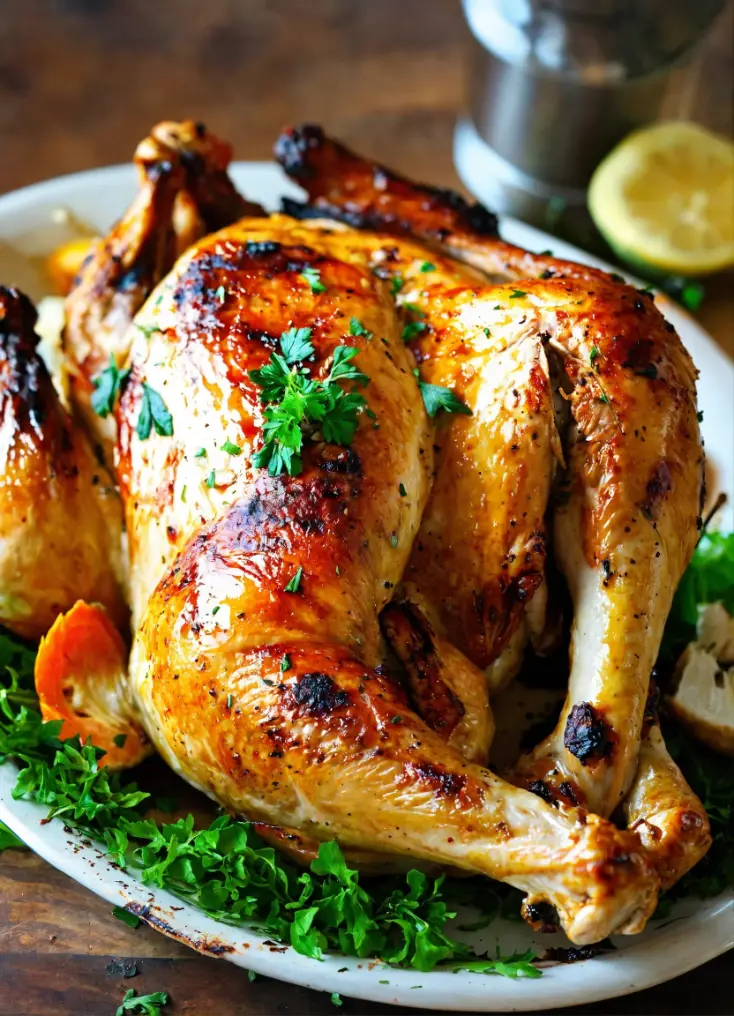Introduction and Preparation
Introduction to Roasted Half Chicken
The art of roasting chicken dates back centuries, with each culture adding its unique touch to this culinary staple. The roasted half chicken has become a global favorite, known for its versatility and ability to absorb flavors from a variety of herbs and spices. This dish is not only a testament to culinary simplicity but also to the rich history and tradition that it carries.
From the smoky charcoal grills of street-side eateries in Southeast Asia to the sophisticated ovens of high-end Western restaurants, roasted half chicken has marked its importance in various cuisines. Its popularity stems from the straightforwardness of its preparation and the universal appeal of its taste. The golden, crispy skin and tender, juicy meat of a perfectly roasted chicken can transcend cultural boundaries, making it a beloved dish worldwide.
In many cultures, roasted chicken is more than just a meal; it’s a centerpiece for family gatherings, festive celebrations, and even ceremonial occasions. Its preparation and cooking methods have been passed down through generations, with each adding their own local ingredients and cooking styles to enhance the flavor and significance of the dish. This adaptability and wide-reaching appeal make roasted half chicken a culinary delight cherished across the globe.
Ingredients for the Perfect Roast
Understanding the food safety guidelines for handling and cooking chicken is crucial. Proper preparation and cooking can prevent foodborne illnesses. Explore food safety for chicken handling to ensure you’re well-informed before starting.
Preparation: The First Step to a Perfect Roast
Preparing a roasted half chicken involves a series of steps that are crucial to achieving the perfect balance of flavors and textures. Here’s a step-by-step guide to help you master the preparation:
-
Clean and Prepare the Chicken:
Begin by rinsing the chicken half under cold water to remove any residual blood or feathers. Pat it dry with paper towels to ensure the skin crisps up nicely during roasting.
-
Marinating:
Although optional, marinating can enhance the flavor significantly. Combine olive oil, minced garlic, chopped herbs, lemon juice, salt, pepper, and paprika to create the marinade. Rub this mixture generously over and under the skin of the chicken, ensuring it’s well-coated. For the best results, let the chicken marinate in the refrigerator for at least 1 hour or overnight, allowing the flavors to penetrate deeply.
-
Seasoning:
If you’re short on time and skipping the marination step, ensure the chicken is well-seasoned. Season both sides of the chicken with salt and pepper, and rub with the mixture of olive oil and herbs. Don’t forget to season the cavity, as it helps flavor the meat from the inside.
-
Stuffing:
Place lemon wedges and a few additional herbs inside the chicken’s cavity. This not only imparts flavor but also helps to keep the meat moist during cooking.
-
Trussing (optional):
For even cooking, truss the chicken by tying its legs together with kitchen string and tucking the wing tips under the body. This step is optional but can help the chicken maintain a good shape and ensure even cooking.
-
Pre-Roasting Prep:
Let the chicken come to room temperature for about 20-30 minutes before roasting. This step reduces the cooking time and helps the chicken cook more evenly.
-
Basting Prep:
Melt some butter and have it ready for basting. Basting during roasting will keep the chicken moist and add an extra layer of flavor.
Marinating the chicken for a few hours, or even overnight, can enhance the flavors significantly. For marination ideas, consider exploring herb marination techniques, which can add depth to the taste and contribute to the overall nutritional value of the dish. By following these preparation steps, you’ll set the stage for a perfectly roasted half chicken, characterized by its flavorful, juicy meat and crispy, golden-brown skin.
Cooking Tools and Equipment
The right cooking tools and equipment are essential for roasting a half chicken to perfection. Here’s what you need and some recommendations for the best results:
- Roasting Pan: A sturdy roasting pan with a rack allows heat to circulate around the chicken, ensuring even cooking and a crispy exterior. Choose one with high sides to catch drippings for making gravy.
- Meat Thermometer: An essential tool to ensure the chicken is cooked through to the safe internal temperature of 165°F (75°C). A digital meat thermometer provides accuracy and quick readings.
- Kitchen Twine: For trussing the chicken, which helps in even cooking and maintaining a good shape.
- Basting Brush: To evenly apply butter or marinade during roasting, keeping the chicken moist and flavorful.
- Carving Knife and Fork: A sharp carving knife and sturdy fork are necessary for slicing the chicken neatly and serving it elegantly.
- Aluminum Foil: Useful for tenting the chicken if it browns too quickly, preventing overcooking and keeping it moist.
Letting the chicken rest for 10-15 minutes before carving allows the juices to redistribute, ensuring each bite is succulent and flavorful. Discover more about the benefits of resting your meat post-roasting.


